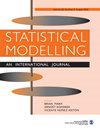基于监督分量的响应混合模型:聚类区系分类群
IF 1.2
4区 数学
Q2 STATISTICS & PROBABILITY
引用次数: 0
摘要
在本文中,我们建议对响应进行聚类,以识别由特定解释组件预测的组。假设响应矩阵取决于一组解释变量和一组附加协变量。解释变量被认为是多的和冗余的,这意味着一些降维和正则化。相比之下,额外的协变量包含很少的被强迫进入回归模型的选定变量,因为它们不需要正则化。假设响应矩阵被划分为几个未知的响应组。我们假设,从解释变量的适当数量的特定正交监督分量中,每组中的响应是可预测的。该分类基于反应的混合模型。为了估计模型,我们提出了一个扩展了基于监督分量的广义线性回归的准则,一种偏最小二乘类型的方法,并开发了一种将基于分量的模型和期望最大化估计相结合的算法。这一新方法在模拟数据上进行了测试,然后应用于植物区系生态学数据集。本文章由计算机程序翻译,如有差异,请以英文原文为准。
Response mixture models based on supervised components: Clustering floristic taxa
In this article, we propose to cluster responses in order to identify groups predicted by specific explanatory components. A response matrix is assumed to depend on a set of explanatory variables and a set of additional covariates. Explanatory variables are supposed many and redundant, which implies some dimension reduction and regularization. By contrast, additional covariates contain few selected variables which are forced into the regression model, as they demand no regularization. The response matrix is assumed partitioned into several unknown groups of responses. We suppose that the responses in each group are predictable from an appropriate number of specific orthogonal supervised components of explanatory variables. The classification is based on a mixture model of the responses. To estimate the model, we propose a criterion extending that of Supervised Component-based Generalized Linear Regression, a Partial Least Squares-type method, and develop an algorithm combining component-based model and Expectation Maximization estimation. This new methodology is tested on simulated data and then applied to a floristic ecology dataset.
求助全文
通过发布文献求助,成功后即可免费获取论文全文。
去求助
来源期刊

Statistical Modelling
数学-统计学与概率论
CiteScore
2.20
自引率
0.00%
发文量
16
审稿时长
>12 weeks
期刊介绍:
The primary aim of the journal is to publish original and high-quality articles that recognize statistical modelling as the general framework for the application of statistical ideas. Submissions must reflect important developments, extensions, and applications in statistical modelling. The journal also encourages submissions that describe scientifically interesting, complex or novel statistical modelling aspects from a wide diversity of disciplines, and submissions that embrace the diversity of applied statistical modelling.
 求助内容:
求助内容: 应助结果提醒方式:
应助结果提醒方式:


